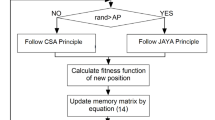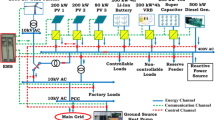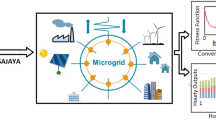Abstract
Economic dispatch (ED) of a grid connected and renewable integrated microgrid system is considered in this paper. Two wind farms take the renewable energy sources (RES) into consideration. A parameter worst-case-transaction-cost which arises due to the stochastic availability and uncontrollable nature of wind farms is also emphasised and efforts have been taken to minimize it too. Hence the paper’s focus into split objective functions and the generation costs and the worst case transaction costs are optimised separately and also the net microgrid cost is optimized as a whole. Two different cases with highly varying transaction prices are studied. Two meta-heuristic soft computing algorithms are applied for optimization and a comparative analysis among them is studied. Numerical results are tabulated to justify the effectiveness of the novel approach.









Similar content being viewed by others
Abbreviations
- T, t :
-
Number of scheduling periods, period index
- M, m :
-
Number of conventional DG units
- N, n :
-
Number of Dispatchable (class-1) loads, load index
- Q, q :
-
Number of energy (class-2) loads, load index
- J, j :
-
Number of DS units and their index
- I, i :
-
Number of power production facilities with RES, and facility index
- \(P_{{G_{m} }}^{\hbox{min} }, \,P_{{G_{m} }}^{\hbox{max} }\) :
-
Minimum and maximum power output of conventional DG unit m
- \(R_{{m,{\text{up(down)}}}}\) :
-
Ramp up (down) limits of conventional DG unit m
- SR t :
-
Spinning Reserve for conventional DG
- L t :
-
Fixed power demand of critical loads in period t
- \(P_{{D_{n} }}^{\hbox{min} }\, P_{{D_{n} }}^{\hbox{max} }\) :
-
Minimum and maximum power consumption of load n
- \(P_{{E_{q} }}^{\hbox{min} ,t} ,P_{{E_{q} }}^{\hbox{max} ,t}\) :
-
Minimum and maximum power consumption of load Q in period t
- \(S_{q} ,T_{q}\) :
-
Power consumption start and termination times of load q
- \(E_{q}^{\hbox{max} }\) :
-
Total energy consumption of load q from start to termination time
- \(P_{{B_{j} }}^{\hbox{min} } ,P_{{B_{j} }}^{\hbox{max} }\) :
-
Minimum and maximum charging and discharging power of DS unit j
- \(B_{j}^{\hbox{min} }\) :
-
Minimum stored energy of DS unit j in time T
- \(B_{j}^{\hbox{max} }\) :
-
Capacity of DS unit j
- \(\eta_{j}\) :
-
Efficiency of DS unit j
- \(P_{R}^{\hbox{min} } ,P_{R}^{\hbox{max} }\) :
-
Lower and upper bounds for \(P_{R}^{t}\)
- \(\underset{\raise0.3em\hbox{$\smash{\scriptscriptstyle-}$}}{W}_{i}^{t} ,\bar{W}_{i}^{t}\) :
-
Minimum and maximum forecasted power output of RES i in time t
- \(W_{s}^{\hbox{min} } ,W_{s}^{\hbox{max} }\) :
-
Minimum and maximum forecasted total wind power of all wind farms
- \(\alpha^{t} ,\beta^{t}\) :
-
Purchase and selling prices
- \(\pi_{q}^{t}\) :
-
Parameter of utility function of load q
- \(P_{{G_{m} }}^{t}\)(CG):
-
Power output of DG unit m in period t
- \(P_{{D_{n} }}^{t}\)(CLASS1):
-
Power consumption of load n in time t
- \(P_{{E_{q} }}^{t}\)(CLASS2):
-
Power consumption of load q in period t
- \(P_{{B_{j} }}^{t}\) :
-
Charging or discharging power of DS unit j in time t
- \(B_{t}^{j}\) :
-
Stored energy of DS unit j at end of period t
References
Ahmadnia S, Tafehi E (2017) Comparison of optimum wind-solar DG, statcom and capacitor placement and sizing based on voltage stability margin enhancement in microgrid with three different evolutionary algorithms. Iran J Sci Technol Trans Electric Eng 41(3):241–253
Alimisis V, Hatziargyriou ND (2013) Evaluation of a hybrid power plant comprising used EV-batteries to complement wind power. IEEE Trans Sustain Energy 4(2):286–293
Askarzadeh A (2017) A memory-based genetic algorithm for optimization of power generation in a microgrid. In: IEEE transactions on sustainable energy
Balachennaiah P, Suryakalavathi M (2015) Real power loss minimization using symbiotic organisms search algorithm. In: 2015 annual IEEE India conference, vol 4, pp 1–6
Barnes M et al. (2007) Real-world microgrids-an overview. In: 2007 IEEE international confrence on system of systems engineering. pp 1–8
Bertsimas D, Litvinov E, Sun XA, Zhao J, Zheng T (2013) Adaptive robust optimization for the security constrained unit commitment problem. IEEE Trans Power Syst 28(1):52–63. https://doi.org/10.1109/TPWRS.2012.2205021
Chen LCL, Li NLN, Low SH, Doyle JC (2010) Two market models for demand response in power networks. In: Smart grid commun (SmartGridComm), 2010 First IEEE Int Conf, pp 397–402
Chen J, Zhang W, Li J, Zhang W, Liu Y, Zhao B, Zhang Y (2018) Optimal sizing for grid-tied microgrids with consideration of joint optimization of planning and operation. IEEE Trans Sustain Energy 9(1):237–248
Cheng MY, Prayogo D (2014) Symbiotic organisms search: a new metaheuristic optimization algorithm. Comput Struct 139:98–112
Das S, Bhattacharya A (2016) Symbiotic organisms search algorithm for short-term hydrothermal scheduling. Ain Shams Eng J. https://doi.org/10.1016/j.asej.2016.04.002
Datta A, Saha D, Das P (2016) Optimal coordination of directional overcurrent relays in power systems using symbiotic organism search optimisation technique. IET Gener Transm Distrib 10(11):2681–2688
Dey B (2015) Energy management of microgrids with renewables using soft computing techniques. no Lc, pp 1–6
Dom AD (2011) Distributed algorithms for control of demand response and distributed energy resources. In: 2011 50th IEEE conference decision control eur. control conf. Orlando, FL, USA, Dec 12–15, 2011. pp 27–32
Federal Energy Regulatory Commission (2012) MISO Daily Report. http://www.ferc.gov/market-oversight/mktelectric/midwest/miso-rto-dly-rpt.pdf
Govardhan MD, Roy R (2012) Artificial bee colony based optimal management of microgrid. In: 1th International conference on environment and electrical engineering. pp 12–17
Guan X, Xu Z, Jia QS (2010) Energy-efficient buildings facilitated by microgrid. IEEE Trans Smart Grid 1(3):243–252
Hatziargyriou N, Asano H, Iravani R, Marnay C (2007) Microgrids. IEEE Power Energy Mag 5(4):78–94
Hetzer J, Yu DC, Bhattarai K (2008) An economic dispatch model incorporating wind power. Energy Convers IEEE Trans 23(2):603–611
Jiang L, Low S (2011) Real-time demand response with uncertain renewable energy in smart grid. In: 2011 49th annual allerton conference on communication control and computing allert. 2011, pp 1334–1341
Jin C, Ghosh PK (2011) Coordinated usage of distributed sources for energy cost saving in micro-grid. In: NAPS 2011—43rd North American power symposium
Khodayar ME, Barati M, Shahidehpour M (2012) Integration of high reliability distribution system in microgrid operation. IEEE Trans Smart Grid 3(4):1997–2006
Koutsopoulos I, Tassiulas L (2012) Optimal control policies for power demand scheduling in the smart grid. IEEE J Sel Areas Commun 30(6):1049–1060
Lahon R, Gupta C (2017) Energy management of cooperative microgrids with high-penetration renewables. IET renewable power generation
Liao GC (2013) The optimal economic dispatch of smart microgrid including distributed generation. ISNE 2013—IEEE international symposium on next-generation electron. 2013, pp 473–477
Liu X, Xu W (2010) Economic load dispatch constrained by wind power availability: a here-and-now approach. IEEE Trans Sustain Energy 1(1):2–9
Mohsenian-Rad AH, Wong VWS, Jatskevich J, Schober R, Leon-Garcia A (2010) Autonomous demand-side management based on game-theoretic energy consumption scheduling for the future smart grid. IEEE Trans Smart Grid 1(3):320–331
Pinson P, Kariniotakis G (2010) Conditional prediction intervals of wind power generation. IEEE Trans Power Syst 25(4):1845–1856
Shi W, Xie X, Chu C, Gadh R (2015) Distributed optimal energy management in microgrids. IEEE Trans Smart Grid 6(3):1137–1146
Stluka P, Godbole D, Samad T (2011) Energy management for buildings and microgrids. In: Proceedings of IEEE conference on decision and control, pp 5150–5157
Tizhoosh H (2005) Opposition-based learning: a new scheme for machine intelligence. In: Proceedings of the international conference on computational intelligence for modeling, control and automation, Austria, pp 695–701
Vytelingum P, Ramchurn S, Voice T, Rogers A, Jennings N (2011) Agent-based modeling of smart-grid market operations. pp 1–8
Wu C, Mohsenian-Rad H, Huang J, Wang AY (2011) Demand side management for wind power integration in microgrid using dynamic potential game theory. In: GLOBECOM Workshops (GC Wkshps), 2011 IEEE, IEEE, pp 1199–1204
Zhang Y, Gatsis N, Giannakis GB (2012) Robust distributed energy management for microgrids with renewables. In: IEEE third international conference on smart grid communication. pp 510–515
Zhang Y, Gatsis N, Giannakis GB (2013) Robust energy management for microgrids with high-penetration renewables. IEEE Trans Sustain Energy 4(4):944–953
Zhao L, Zeng B (2012) Robust unit commitment problem with demand response and wind energy. In: 2012 IEEE power energy society general meeting, no i, pp 1–8
Acknowledgements
The authors are very grateful and would like to thank the anonymous reviewers for their constructive comments.
Author information
Authors and Affiliations
Corresponding author
Rights and permissions
About this article
Cite this article
Dey, B., Bhattacharyya, B. & Sharma, S. Optimal Sizing of Distributed Energy Resources in a Microgrid System with Highly Penetrated Renewables. Iran J Sci Technol Trans Electr Eng 43 (Suppl 1), 527–540 (2019). https://doi.org/10.1007/s40998-018-0141-x
Received:
Accepted:
Published:
Issue Date:
DOI: https://doi.org/10.1007/s40998-018-0141-x




